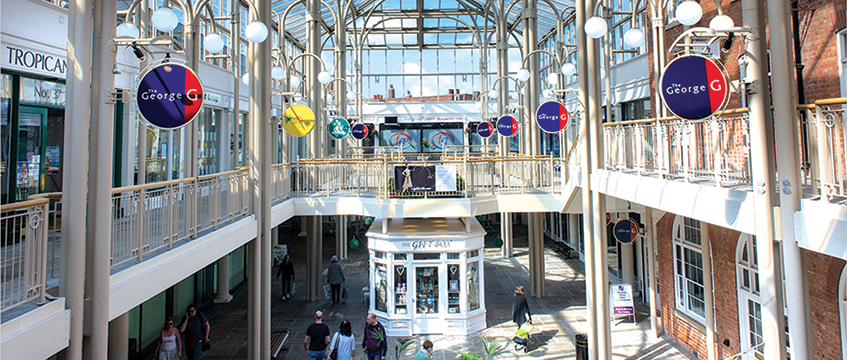What makes the perfect auction lot? “One that creates competition,” says Patrick Kerr, Allsop’s head of commercial auctions.
For a committed seller looking to dispose of stock for which there is keen private investor appetite, the route to auction is often clear cut.
“Shops with upper parts, offices, small industrial estates, ground rents, regulated tenancies, buy-to-lets – if you’re in the market to buy that stock, then your first port of call is the auction room,” Kerr says.
For private investors, auction offers a huge range of choice – and a level playing field unattainable in any other area of the market. For sellers, it offers certainty that the market is going to come to compete for that property.
“Lot size shouldn’t necessarily be a factor determining whether a property is right for auction or not,” Kerr adds. “It’s whether there’s good competition and whether you’re going to drive the best price.”
In the quest for best price, Allsop sometimes uses a hybrid approach too – harnessing the best aspects of private treaty and auction. As the UK’s largest auctioneer by total raised (£1.2bn last year) and with private treaty specialists sitting alongside both its commercial and residential auctioneers, Allsop is uniquely placed to offer this service.
Complex assets
Here, assets that are more complex or that have not found a buyer are marketed three or four weeks or even two months before the auction on the basis that they will go into the catalogue and under the hammer if a bid is not accepted first. They are marketed with a guide price and an auction contract is drawn up ready to be signed – meaning that exchange is immediate whether it happens inside or outside the room.
It is a method the firm has used increasingly over the past five years as the auctions market has matured and become more sophisticated, supported by investment in new technology.
For sellers of larger commercial and residential assets valued at around £5m to 10m, auctions are growing in popularity and this has driven take-up of the hybrid approach. Crucially, it enables them to reach a wider market, including buyers who may not have considered auction, and still keep the advantage of certainty of sale.
For buyers, it provides the extra time needed to carry out due diligence on a complex asset. It also provides the opportunity to say early how serious you are, and this is the best approach for a buyer to adopt, says Allsop. Don’t try to be too smart, there’s no room for bluffing.
Recent successes have included two secondary shopping centres in Grantham and Rochdale. Both were complex assets with lengthy tenancy schedules and ever-changing rent rolls. The George Shopping Centre in Grantham was sold on behalf of a private investor, and the Wheatsheaf Shopping Centre in Rochdale on behalf of a Receiver.
The George, with an annual rental income of £367,000, caught the eye of a South African private investor when it was marketed in a private treaty campaign with an auction “backstop”. This extra marketing time gave her the chance to become familiar with the asset, but it was only in the heat of the auction room that she decided to go for it. She placed the winning bid of £2.7m off a guide of £2.7m-plus.
The Wheatsheaf played out differently. Owing to a large amount of tenant voids, the asset produced a negative net income for the receiver. This time the property was sold before the auction took place, for around £1.5m.
Aggressive bidding
“We were approached by a buyer who bid aggressively, ahead of expectation,” says partner Alex Butler, head of Allsop’s private client team. In consultation with the client, Allsop took the view that the offer could not be bettered in the auction room. “We knew the buyer and their track record gave us confidence,” he adds.
For this approach to work effectively, it is vital that other potential bidders are kept in the loop, Allsop says. “We need to be sure that we have the highest bid. We have a duty to our client,” Kerr says. What’s more, those who have done a lot of due diligence expect to be able to bid at some point. “We want to give everybody the chance to bid,” he adds.
Technology plays a key part in this: Allsop knows who has registered an interest in a particular asset through its website and who has gone on to download the legal pack. These potential buyers will be contacted and invited to bid.
The hybrid approach is working well for some residential opportunities too. For commercial lots suitable for residential conversion using permitted development rights, for example, the additional marketing time allows interested parties to thoroughly research the planning situation. This was certainly the case for 28-40 The Broadway, Cheam, which comprised retail on the ground floor with a vacant office above. Following a private treaty campaign, this was sold to a residential developer prior to auction at £3.15m, well in excess of the guide price.
Allsop has also used the hybrid approach to market developments of new homes, such as five new-build town houses sold for Notting Hill Home Ownership earlier this year. The homes in Islington had failed to sell on the open market. Allsop advised the housing association to adjust its pricing and re-market the homes with an auction backstop. They were subsequently sold prior to Allsop’s March and May auctions.
“We have found it to be an effective way of raising awareness and interest in new homes for developers, because the auction provides finality,” says Allsop residential partner Gary Murphy.
“We have an auction database of 220,000 subscribers who have opted in to receive our catalogues. That’s world-wide. We are also building a new homes purchaser database. Combining that with the finality of an auction date and the weight of our auction teams is a formidable method for selling new homes,” he adds. “For medium-sized housebuilders, this is a cost-effective way of getting enormous reach.”
Auctions has always been about reaching the right market for the asset, creating a level of competition that will drive the best price – be it for a buy-to-let, a PDR opportunity or a commercial investment. It is an age-old formula that works for buyer and seller alike. But as Allsop, founded in 1906, is demonstrating, there are always ways to enhance how effectively and efficiently this is achieved.
To send feedback, e-mail julia.cahill@egi.co.uk or tweet @egjuliac or @estatesgazette
Auction Gold: typical residential and commercial lots
■ Lot 3, March 2017
Chelsea, SW10: Long leasehold first, second and third floor maisonette with possible potential for internal reconfiguration
Guide £750,000+
Sold £1.15m
■ Lot 8, March 2017
Paddington, W2: Two well-located leasehold units presented in shell condition and located on the lower ground and ground floors. Planning permission granted for amalgamation of both units into a single two-bedroom dwelling.
Guide £810,000+
Sold £1.15m
■ Lot 26, March 2017
Greenford, Middlesex: Freehold detached former health centre (D1 use) with possible potential for change of use/redevelopment subject to obtaining all necessary consents
Guide £900,000-£950,000
Sold £2m
Commercial
■ Lot 22, February 2017
Chesterfield, Derbyshire: Co-op convenience store. Secondary location but a very long lease to the Co-op (2031 – no breaks) with RPI-linked reviews.
Sold for £970,000 at an initial yield of 4.85%.
■ Lot 20, May 2017
Acton, London: A London suburban shop with flat above let on an AST. Private tenant was a hairdresser with a break clause in 2018. Sold for £660,000, just below our long-term average lot size and showed an net initial yield of 4.32%. A well fought over lot that sold for just under £100,000 above reserve.















